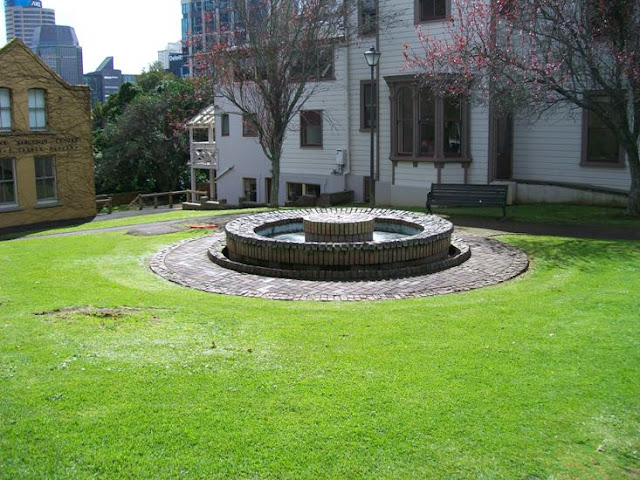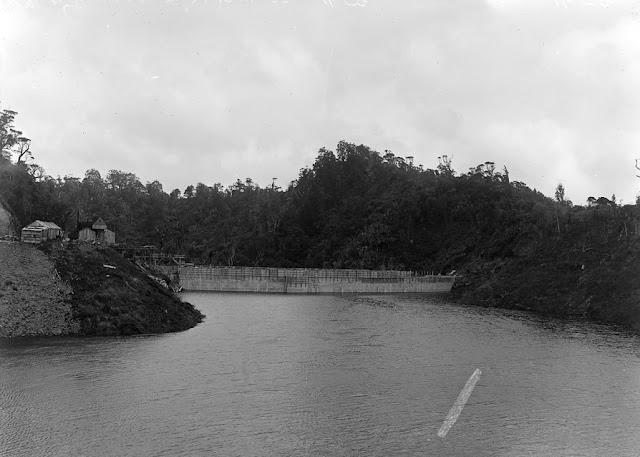"Showing the pipeline at the Nihotupu Reservoir," James D Richardson, 1919, Sir George Grey Special Collections, ref. 4-1669, Auckland Libraries
A bit of a sequel to my
Waitakere Dam Tramline visit.
Last Thursday, thanks to my friend and fellow AWHS member Tony Goodwin, I got a chance to visit the
Rainforest Express, a passenger tramline running from Jacobson's Depot to the Upper Nihotupu Dam in the Waitakere Ranges. Exactly who Jacobson is or was, I still have no idea, but I'll be asking West Auckland folk about that. The tramline has been running, so they told us, for 14 years now. Tony said to me that the rail used is what is called "30 pound", either not manufactured today or extremely hard to obtain. So, much of the old line to Huia was ripped up and used as spare parts to maintain the line here.
Speaking of spare parts -- such was the fate of this old relic as well.
"Vertical boilered steam locomotive on line between Big Muddy Creek and bottom of incline, used in the construction of the Upper Nihotupu Dam", Henry Winkelmann, Sir George Grey Special Collections, ref. 1-W1803, Auckland Libraries
According to the plaque tacked to the rear, this is an Orenstein & Koppel Locomotive, built in Berlin in 1906 for the Northern Coal Company in Waro. Auckland City Council purchased the loco from the company in 1921 and put it to work on the Nihotupu dam construction project, costing £140. "The Orenstein & Koppel was the main working locomotive used to haul building material for the dam from the wharf at Big Muddy Creek along the old lower Nihotupu line (removed in 1923) up to the incline where a steam winch hauled the wagons up to the Upper Nihotupu line." There was also a vertical boiler engine, seen in the historic photo above.
The loco at the Mokau colleries after 1923. From the interpretive panel, Alexander Turnbull Library.
From 1923, after it was sold again, the loco worked down near Waitomo, and at the end of its career ended up in a display in Tauranga, possibly the
Historic Museum they once had down there. Deteriorated, it ended up at MOTAT in 1989 ... and was dismantled and scavenged for spare parts for MOTAT's 1904 Bertha locomotive. In March 1998, when Watercare began the restoration of the tramline from Jacobson's Depot, the remains of this engine were handed over by MOTAT on long term loan. Now, what remains is painted against the elements, up on blocks, and kiddies climb into the cabin to imagine days gone by when the loco once travelled along the narrow gauge.
The tramline winds its way along a pipeline taking untreated water from the Upper Nihotupu Dam towards the nearest filter station.
"Showing the pipeline at the Nihotupu Reservoir," James D Richardson, 1919, Sir George Grey Special Collections, ref. 4-1667, Auckland Libraries
Above is a piece of pipe they've left as a display to view while the train goes past -- airlocks, so the commentary went, can cause explosions leaving damage like this. Not something easy to fix all the way up here on the ridges.
"The Nihotupu tramline and pipe route during construction of the Upper Nihotupu Dam, with locomotive used to haul construction material to dam site," Henry Winkelmann, Sir George Grey Special Collections, ref. 1-W1784,
Auckland Libraries
"Garth's two-horse coach in the vicinity of Nihotupu", 1915, James D Richardson, Sir George Grey Special Collections, ref 4-2441, Auckland Libraries
Nihotupu was a major tourist attraction from the 1890s or so. The old Avondale Stables made a bit of a killing hiring brakes that would set up for West Auckland and to head up to the Waitakere Ranges so that well-dressed ladies, gents and children could admire Nature's majesty and the wonder of the Nihotupu Falls.
"A view of Nihotupu Falls, with Amy and Jean Richardson and Miss Hunt standing below," 1913, James D Richardson, Sir George Grey Special Collections, ref 4-2458, Auckland Libraries
All that's gone, now. The falls are now vanished beneath the waters of the great holding dams built by a thirsty Auckland in the 20th century.
Today, from the Arataki Visitor's Centre up above the tramline, and from the tramline itself (much more briefly), you get to admire the scene of the lower Nihotupu Dam, and the Manukau Harbour beyond. It's still the sort of view I'd love to have from a house window, though.
Bits and pieces like this coal scoop are left along the line. Although, there wasn't actually any coal-mining here ...
Very narrow, these tunnels. Keep your head and hands in!
One of the blokes headed off into this tunnel around of the train so he could shine his torchlight on the inhabitants for us.
Wetas. Lots of 'em.
A bit of a pause at Quinn's Bridge, across Quinn's Creek (and no, I don't know who Quinn is either. Another mystery to solve.)
Onward we go ...
Almost at the dam ...
And there it is: the Upper Nihotupu Dam. Instead of waterfalls, there's water cascading in a foamy jet of overflow at the bottom, and the green face of the dam.
And a lot of steep steps up to the top of the dam. Yes, I climbed them. With my state of unfitness, ladies and gents, I needed both arms as well as the legs to haul my overweight mass up there. And at least two breather stops while my lungs discussed impending industrial stop work action. I tell you what -- if you have a bit of congestion in the pipes, that walk will clear things out, no worries ...
Update 26 September 2011: Above is a photo taken by Tony Goodwin of yours truly climbing the steps. Thanks, Tony!
"Nihotupu Dam from the west bank in the Waitakere Ranges", Henry Winkelmann, 31 October 1923, Sir George Grey Special Collections, ref. 1-W368, Auckland Libraries
I did make it, though (well, with the steps, once you start, there's only one way out, and it's up).
A long way down. That's what is left of the falls, down below.
"A view of the dam under construction at the Nihotupu Reservoir", James D Richardson, 1922, Sir George Grey Special Collections, ref. 4-1658, Auckland Libraries
By late 1910, Auckland City Engineer Walter Bush identified a site in the Upper Nihotupu valley for a earth or puddled clay core dam. The Council accepted the proposed site in January 1912, then engaged H H Metcalfe to produce a feasibility report (getting an engineer to comment on another engineer's idea? Might have been galling.) Metcalfe, best known for his waterworks at Lake Pupuke up on the North Shore, suggested a concrete dam instead, on a site downstream from the existing timber one. Bush suggested another site, and this was disputed by Metcalfe. So the Council called in a third engineer, a chap named Morton from Wellington, to report on the whole matter. (Three engineers now?) Morton supported Bush's No. 3 site, and Council began making preparations -- interrupted, of course, by World War I.
"A view of the dam under construction at the Nihotupu Reservoir", James D Richardson, 1922, Sir George Grey Special Collections, ref. 4-1659, Auckland Libraries
February 1919 was when concreting began. During construction, Auckland went through a water shortage in 1920, so an auxiliary dam was built and brought into service at Bush's No. 1 site. Work continued at the main dam though, with Mayor James Gunson officially turning on the water at the new dam 20 December 1920.
Things were falling behind schedule by January 1921, however, and the contractor, Langlands and Company, was in serious difficulties due to shortages of materials and labour after the war. The cost of the project therefore escalated by nearly 70 per cent, Council took over control the next month, and reorganised the entire project. The completed dam was officially opened by Joseph Coates, Minister of Works, 14 April 1923. (Information from Walls for Water: Pioneer Dam Building in New Zealand, R E Offer, 1997.)

Labour troubles and industrial unrest would vanish quickly if every body of employers adopted the same attitude toward their workmen, as the Auckland City Council has done with regard to the men who built the great Nihotupu Dam, remarks the New Zealand Herald. Reference to the part played by the actual workers, made by the Mayor at the opening ceremony, was greeted with loud applause from over a thousand listeners. "We are proud to say that there has not been a single accident on the job since the council took it over," Mr. Gunson said. "The utmost precautions have been taken for the safety of the men, and everything possible done for their welfare in the way of comfortable accommodation and facilities for recreation. In allotting the credit for the completion of this great undertaking, I wish particularly to mention the foreman and the men themselves. It has been a source of deep pleasure and admiration to us all year by year to see the way in which these men have worked, and the interest they have taken in their job, and to-day on behalf of the council and Auckland citizens, I wish to acknowledge our indebtedness to the staff of sixty or seventy men who have seen the building of the dam through to completion.''
Hawera & Normanby Star, 8 May 1923
The brass thieves haven't made it up here yet, so it seems (that walk up the steps, even if they got past the barred gates, would probably deter the ratbags).
"Showing the official opening of the Nihotupu Dam in the Waitakere Ranges," 14 April 1923, James D Richardson, Sire George Grey Special Collections, ref. 4-5891, Auckland Libraries
"Relatively this is only a small job," said the Mayor (Mr J. H. Gunson) at the opening ceremony at Nihotupu dam on Saturday. "Huge as it appears to us, it is really nothing very big, and this will be appreciated when I say that all this water would last London only two days. You see, after all we are a small people, in a small community, and must be humble."
Hawera & Normanby Star, 20 April 1923
We were allowed into the control room.
Then a walk along to the picnic area ...
... where the train waited to take us back down the line.
At the depot once more.
Along the way back, we were told about
Kauri Snails, nocturnal carnivorous cannibals of the bush, said to inhabit the rainforest beside the tramline. The workmen find empty snail shells now and then, and they keep these in a display case at the depot. If they're Kauri Snails, they're a bit south of their usual Northland range, and a bit small.
So, briefly, that's the Rainforest Express. Worth a visit, it runs in all weathers and seasons, and the view of the glow worms is magical.
























































































